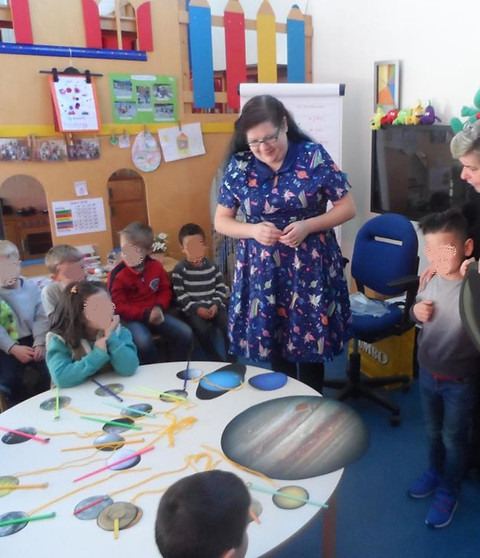
Astronomy lessons
I am happy to be invited to your school, library, community center, or extracurricular group to give an astronomy lesson. Below are descriptions of the lessons that I have already, but if you have a particular interest, we can discuss the design of a new lesson.
My native language is English, but I am comfortable giving these lessons in Dutch as well!

Solar System Dance
This interactive in-person lesson (aimed at children 4-8 years old) explains cool facts about each planet in our solar system as well as some dwarf planets and several moons. The students each choose a physical representation of a solar system object (all to scale) and will move around to represent their object.
For classes of more than 20, I can also add in some interesting recent solar system missions.
Note: This lesson requires a lot of floor space!

Constellation Crafting
In this lesson (suitable for 4-12 year olds) we will talk about the stories behind some of the northern constellations and make our own constellations with paper stars of different colors and sizes. For older students, I will discuss why stars have different colors and sizes in more depth.
The children may copy existing constellations or create their own with a story to go with it.
Note: This lesson requires a location with tables and chairs for crafting.

Orion Nebula across the spectrum
In this lesson (suitable for 6+ years old) we talk about what telescopes can see in different types of light. We use space art stickers based on real observations of the Orion Nebula to show how X-Ray, Near Infrared, Mid Infrared, Far Infrared, and sub-millimeter light looks compared to ordinary visible light.
For older students (12+) I can also demonstrate observational astrochemistry data using props.
For ideal engagement smaller groups (~20 students) are preferred, but this can also be adapted to a large group with extra preparation and volunteers.

Stunning spectra
In this lesson (for age 6+) we learn about the colors of light and how different materials have shine in different colors. The "spectra" or different color light, that comes from a material tells us about what is is made of.
We will make our own spectroscopes and look at different materials (with break-resistant spectral lamps).
Smaller groups are ideal (15-20), but larger groups are possible.
Note: a location with tables and chairs is necessary for the craft and electricity is needed for the spectral lamps.

Exoplanets and astrobiology
This lecture+workshop (aimed at students 7-14 years old) starts with identifying our cosmic address and introduces the concept of exoplanets and the possibility of life outside the earth. This links into how different earthly creatures have evolved to fit their environment and students are challenged to think of different adaptations that alien creatures would need.
This lesson suits a large audience for the lecture, but the follow-up craft is best in smaller groups (~10).

The Life and Death of stars
In this lesson (suitable for 8-14 year olds) we use balloons to understand how stars form, grow, live, and die (sometimes explosively!).
This lesson can accommodate 20 students easily, but it you have a larger group then we need a very large space!
It adds impact to combine this with the constellation lesson to address both the human connection and scientific nature of stars.
Note: This lesson involves balloons occasionally popping. I warn the students before popping them so those who find it stressful can cover their ears or withdraw.
.png)
Something new coming soon!
For ideal engagement smaller groups (~20 students) are preferred, but this can also be adapted to a large group with extra preparation and volunteers.

More new lessons
In this lesson (for age 6+) we learn about the colors of light and how different materials have shine in different colors. The "spectra" or different color light, that comes from a material tells us about what is is made of.